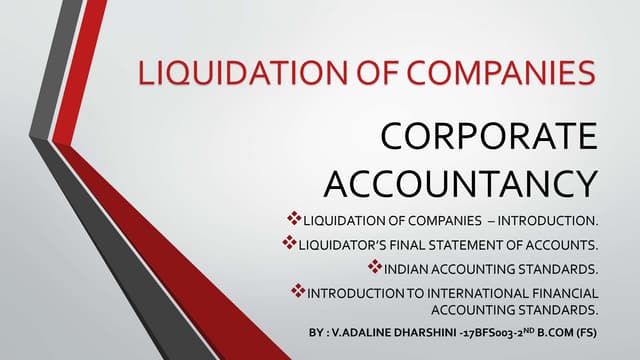7 Easy Facts About Company Liquidation Explained
7 Easy Facts About Company Liquidation Explained
Blog Article
More About Company Liquidation
Table of ContentsThe Ultimate Guide To Company LiquidationThe Company Liquidation PDFsThe Single Strategy To Use For Company LiquidationThe Greatest Guide To Company LiquidationAbout Company Liquidation
A liquidator is especially assigned to look after the ending up of a firm's events in order for it to be folded generally when the company is going bankrupt. The liquidator is an objective 3rd party that looks after the sale of firm properties in order to repay any kind of outstanding debts.Their function consists of, yet is not restricted to: Objective Overseer: A liquidator is tasked with serving as an unbiased third party to oversee the whole business liquidation process. Create Declaration of Matters: Liquidators should create a detailed statement of affairs record. This file is distributed to financial institutions, outlining the present economic condition of business at the time of its liquidation.
After the liquidation of a firm, its existence is eliminated from Companies Residence and it stops to be a lawful entity. If supervisors navigated the procedure uncreative, there would be no penalties or individual liability for strong financial debts expected. Currently, with a tidy slate, directors can explore brand-new company opportunities, though expert consultation is recommended.
The Definitive Guide to Company Liquidation
As an example, if greater than 90% of all business shareholders concur, liquidation can happen on brief notice within 7 days, the minimum statutory notice for creditors. Nonetheless, typically, the larger the liquidation and the even more properties and funding the organization has, the longer the process will take. 'Do I need to pay to liquidate my business?', the solution will certainly depend upon whether your company has any type of assets remaining when liquidating.

We recognize that no 2 business coincide, which is why we will certainly make the effort to be familiar with your service so we can advise the very best course of activity for you. We just work in your benefits, so you can be absolutely certain in the solution we provide.
Top Guidelines Of Company Liquidation
In the UK, there is a set process to shutting down or restructuring a minimal business, whether it is solvent or insolvent. This procedure is called liquidation and can just be managed by an accredited bankruptcy expert (IP) in accordance with the Bankruptcy Act 1986. There are four major kinds of firm my link liquidation process: Creditors' Voluntary Liquidation (CVL); Compulsory liquidation; Management; and Members' Volunteer Liquidation (MVL).

In these scenarios, it is essential that the business stops trading; if the organization continues to trade, the supervisors could be held directly accountable and it can lead to the bankruptcy practitioner reporting wrongful trading, called misfeasance, which might lead to lawsuit. The supervisors assign an insolvency specialist and as soon as this has actually been agreed and confirmed, there is a meeting with the shareholders.
Of training course, if there are no investors, this action of the procedure is not essential (Company Liquidation). The IP takes control of the company and begins the business liquidation procedure. The directors are no longer included in what takes place, consisting of the sale of the company's assets. If the supervisors desire any of the assets, they can notify the IP.
Top Guidelines Of Company Liquidation
The primary difference is that the firm's creditors related to the court for an ending up order which requires the insolvent firm into a liquidation process. Creditors take this activity as a last resort due to the fact that they have not received repayment via various other forms of negotiation. The court selects my link an insolvency practitioner, likewise called a main receiver, to perform the obligatory company liquidation procedure.
This kind of firm liquidation is not voluntary and supervisors' conduct is reported to the UK's Secretary of State once the liquidation procedure has been completed. Therefore, any kind of director that falls short to comply with the IP or has been associated with supervisor misbehavior, or a fraudulent act, might cause major effects (Company Liquidation).
It is used as a method to safeguard the company from any type of legal action by its financial institutions. The supervisors of the business concur to make routine repayments to resolve their financial obligations over a duration of time.
Top Guidelines Of Company Liquidation
This provides the company with time to create a strategy going onward to rescue the company and avoid liquidation. At this point, supervisors hand control of the business over to the designated administrator. If a firm is solvent however the directors and investors wish to close the organization, a Participants Voluntary Liquidation is the right alternative.
The business liquidation process is taken care of by a liquidator appointed by the directors and investors of the business and they have to authorize a declaration that there are no financial institutions remaining. The liquidation procedure for an MVL is similar to that find more of a CVL because assets are become aware however the proceeds are distributed to the supervisors and the shareholders of the firm after the liquidator's fees have actually been paid.
Report this page